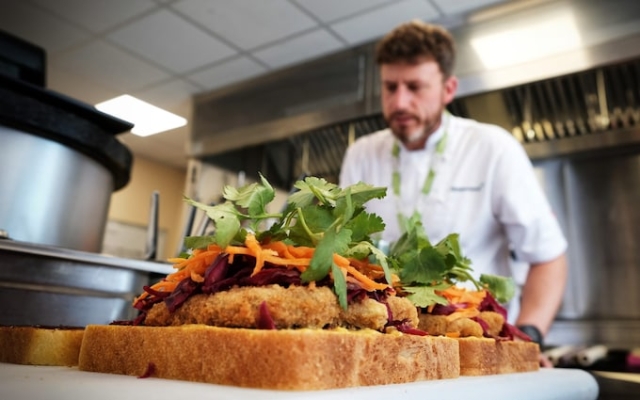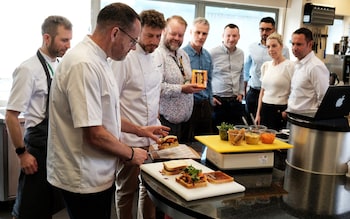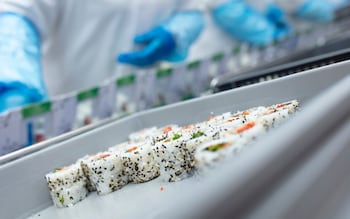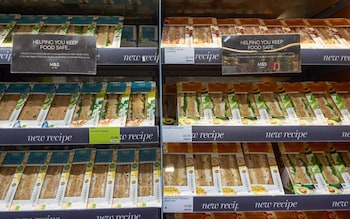 Tagging & Spencer has implemented innovative methods to avoid some of the common pitfalls associated with supermarket sandwiches. Photo: John Robertson
Tagging & Spencer has implemented innovative methods to avoid some of the common pitfalls associated with supermarket sandwiches. Photo: John Robertson
When Marks & Last year, Spencer executives decided to shorten the shelf life of sandwiches from three days to two, but some questioned whether this was entirely necessary.
After all, other supermarkets kept the sandwiches on sale. within five days after their manufacture. If products had to be removed from shelves that had left factories just two days earlier, wouldn't that have forced the retailer to discount more sandwiches?
But M&S Food managing director Alex Freudmann says the decision was a no-brainer. “We want this product to be absolutely perfect at best before for the customer to eat.”
The problem was that the texture of the bread was wrong when it was left in the refrigerator for too long. “From my point of view, it took two days for M&S to achieve this quality,” says Freidman.
Since the changes took effect, they have actually resulted in fewer discounts on sandwiches in stores.
“Customers buy more of them because the quality is better,” says Freudmann. He said it shows that “quality, quality, quality is everything.”
The sandwich shift is part of an ongoing reboot at Marks & Spencer, stepping up efforts to increase sales at its restaurants.
 M&S's &# 39;fortress' the centers produce some of the most important food lines. Photo: John Robertson
M&S's &# 39;fortress' the centers produce some of the most important food lines. Photo: John Robertson
For years, as M&S embarked on a turnaround, the focus has been on reviving the traditionally less dynamic clothing and homeware divisions.
However, there is a lot of work going on behind the scenes on how to attract more customers in supermarkets.
When M&S publishes its annual results on Wednesday, analysts expect the company to report pre-tax earnings up 42%. Profit is a consensus estimate of £684 million.
As the retailer anticipates further growth, its food halls are expected to play a central role in boosting sales.
«It was one of those things that was quietly going on in the background,» says Nicholas Found, senior consultant at Retail Economics. “But actually, if you compare it to a few years ago, there have been a lot of incremental changes and shoppers are really gravitating towards them.”
M&S has already outlined its long-term goals to investors. . In plans unveiled last year, the retail giant said it wanted to increase its share of the grocery market by one percentage point by 2028, suggesting its target would be between 4.4% and 4.6%.
< p>This is a significant ambition. The latest NIQ data shows its share stood at 3.6% at the end of March. A rise above 4% would see M&S overtake Waitrose, whose market share currently stands at 3.8%, for the sake of scale.
But bosses are reluctant to suggest that is the goal. “We say that we compare ourselves only to ourselves,” Freidman insists. When it comes to attracting customers, «we win if we win everywhere,» he says.
The plan isn't just to offer shoppers more range: M&S's focus has been on expanding its fresh produce range for some time, with analysts suggesting larger baskets will help the retailer attract shoppers.
However, M&S actually has another advantage that it expects will help boost sales across all its stores, regardless of the popularity of its expanded fresh produce range.
The areas where it is usually already strong are pre-prepared foods. salads, sandwiches, rolls and cakes — there is still room for improvement. How? The answer can be found in the food manufacturing network.
Across the UK, M&S has created a cluster of so-called «fortress» factories.
Although these are not technically M&S factories, they are run by some of the largest British baking groups, manufacturers and sandwich makers — they are quite close.
 To prepare the sushi, supplier M&S Greencore installed a State-of system — the latest Japanese equipment — at its Northampton plant. Photo: electric_egg
To prepare the sushi, supplier M&S Greencore installed a State-of system — the latest Japanese equipment — at its Northampton plant. Photo: electric_egg
By partnering with companies such as Greencore and Bakkavor, M&S has been able to secure sole ownership of some of the UK's most advanced food factories. Other supermarkets usually prefer to source their products from shared factories.
The fortress centers are responsible for producing some of M&S's most important food lines, from Colin the Caterpillar cakes to a huge range. sandwiches and salads that you can take to the office. They produce around £1 billion worth of M&S food products.
“Wherever we have a product, we want it to differentiate itself in quality from the market,” says Freudmann. He says M&S can maintain that gap by essentially fencing off its product aisles.
Food expert Ged Futter says it is vital for M&S to put a «clean water» between it and its rivals as others race to catch up. «We see that they are really aware that others are trying to copy their quality.»
A good example of how M&S is working to differentiate its products is at the large Greencore campus in Northampton, where the pair have worked together to install new kits with goal to improve the quality of their sandwiches, rolls and sushi.
There, food production lines use more manual labor than usual, and employees are hired to place shrimp on slices of bread to make the «best shrimp sandwich» to ensure even distribution.
 Staff carefully prepare sandwiches by hand in a bid to enhance the quality of M&S products. Photo: John Robertson
Staff carefully prepare sandwiches by hand in a bid to enhance the quality of M&S products. Photo: John Robertson
M&S has also been able to introduce new food developments to avoid some of the usual pitfalls associated with supermarket sandwiches.
For example, specially grown tomatoes have been in development for many years. They have less moisture than regular tomatoes, so they don't seep into sandwiches and make them soggy.
Greencore installed state-of-the-art Japanese equipment on site to make sushi. M&S is expected to revamp its sushi line next year.
“Essentially we have a differentiated capability and we can do it in a way that, from a shareholder perspective, there is no capital cost,” says Freudmann.
“We get the benefits.” quality and investment, but we can direct our capital where we want to spend it.”
This was in areas such as food service improvement, which was clearly identified as an important focus for the retailer.
Signs & Spencer is set to spend £480 million modernizing its stores, with plans to open 180 major food, clothing and homeware stores and 420 grocery stores by early 2026. grocery stores early last year.
However, bosses say there is still work to be done on what is sold in stores. This year M&S will «refresh» 1,000 of its best-selling products from the roughly 5,000 lines it sells in grocery stores. This follows an increase in the number of products to 1,000 last year.
 Signs' Plans to revamp its best-selling products have raised questions about how it will affect prices. Photo: Marcin Rogozinski/Alamy Stock Photo
Signs' Plans to revamp its best-selling products have raised questions about how it will affect prices. Photo: Marcin Rogozinski/Alamy Stock Photo
In some cases, this meant a lot of changes, such as adding more mayonnaise and butter to sandwiches or improving the quality of the bread. A recipe to keep it from getting too hard or too soft.
Not surprisingly, the push for renewal has raised questions about what that means for prices.
One insider says it's best to «get the best quality without making things unaffordable.» This is something M&S has «done right in the last couple of years compared to what it was in the past», says a former director.
So far it appears M&S is managing to walk that fine line. . Which? The December report found that M&S was comparable in price to rivals on many key food items.
Freidman says what's critical is that M&S can demonstrate value, which is a little different from just price. “Obviously price is part of it, but so is quality. Customers tell us the food is great value for money.”
M&S, he says, cannot afford to slow down. That's why changes like shortening the shelf life of sandwiches are so important.
«We're constantly re-evaluating this issue,» Freudmann says. “The UK retail sector is so competitive that everyone is always trying to copy us and catch up with us. Our goal is to continue to reinvest to maintain this gap every year.”
























































Свежие комментарии